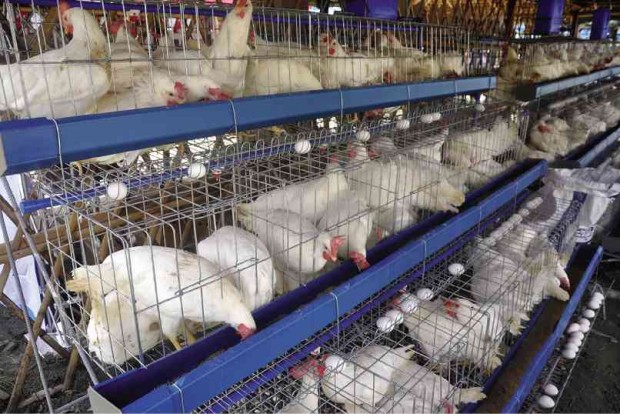Lockdowns pushing hog, poultry raisers to bankruptcy
The series of lockdowns in the country is pushing most food producers to the brink of collapse as demand even for basic commodities such as meat and fish is expected to decline during the two-week lockdown in Metro Manila starting Aug. 6.
Making matters worse is Agriculture Secretary William Dar’s statement, issued in a press briefing on Wednesday, that the agency would not be giving dole-outs to agricultural workers and related businesses.
Leaders of the poultry, livestock and fisheries industries said the closure of nonessential establishments as part of the strict enhanced community quarantine in Metro Manila and nearby provinces would lead to thousands of job losses and, in turn, to lower consumption of their products.
Backyard poultry raisers in particular are expected to reduce operations again to prevent further losses.
“Although our production is already low, the consumption and demand are much lower. In meat, we have an oversupply [that is being] worsened by the arrival of imports,” said United Broilers Raisers Association president Bong Inciong. “Everyone’s problem is demand because people don’t have the money to buy anymore.”
Lower prices
Price monitoring reports of the Department of Agriculture (DA) showed that chicken and pork prices had declined slightly from their levels a week ago. Fish prices were stable as the dampened demand was offset by the reduced production after recent typhoons prevented fishers from going out to sea.
Edwin Chen, president of the Pork Producers Federation of the Philippines, said they were seeing the same trends in the livestock industry.
He noted that as the two-week lockdown neared, panic buying might be exclusive only to the rich, who would most likely troop to supermarkets than to public markets.
The plight of hog raisers could be worse. Unlike in poultry, the production cycle for hogs is 10 months against chicken’s 30 days. This means those in the livestock industry cannot immediately stop production to at least cut losses.
“There’s no adjustment for us here. We cannot do anything,” said Alfred Ng, a hog raiser in Sta. Maria, Bulacan.
“Some may just decide to sell their piglets to avoid the high production costs. Aside from the low demand, the pandemic and the African swine fever, we are also going up against imports. Just imagine that,” Ng said.
As of July 5, the National Meat Inspection Service reported that 97 percent and 66 percent of the country’s chicken and pork inventories were imported. The volume does not include pork shipments—imported at lower tariffs—that are scheduled to arrive in October.
Joseph Sonny Jeruele, a fishing boat captain in Infanta, Pangasinan, said the lockdown would likely leave his family hungry, adding that their crew had not sailed since Typhoon “Fabian” entered the country and the bad weather caused by the southwest monsoon or “habagat.”
Jeruele works with 22 other fishermen whose main livelihood is fishing.
Favored sector
Rice farmers tilling two hectares and less would be better off as they would be entitled to cash assistance worth P5,000 by October, according to DA spokesperson Noel Reyes.
The money would come from excess rice tariff collections amounting to P7.6 billion.
The Philippine Statistics Authority has yet to provide data on palay prices since January this year, but farmers’ groups say staple crops such as rice and corn have been faring well despite the pandemic.
As of Wednesday, the price of well-milled rice remained stable at an average of P44 a kilo. Prices of special and premium rice hovered between P46 and P52 a kilo.
Corn prices, however, skyrocketed to a 10-year high of P22 a kilo from the prevailing rate of P14.50, prompting the DA to consider slashing the tariffs on imported corn to bring down the cost of raising poultry and livestock that use yellow corn as a primary ingredient for animal feed.
Vegetable prices also increased this week due to the recent typhoon that hampered the movement of vegetables from upland areas, according to Agriculture Undersecretary Ariel Cayanan. INQ
